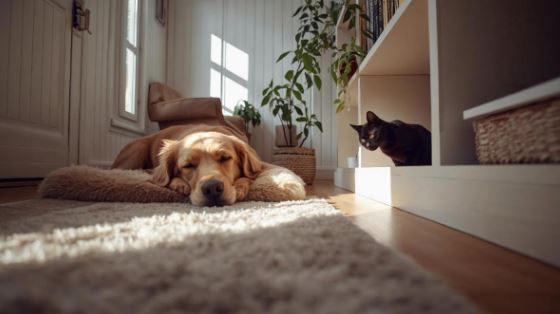By: Lauren Szyszka, Phone Department Supervisor

Our pets are naturally curious — and that curiosity can sometimes lead them into sticky (or even dangerous) situations. From sneaky counter-surfers to playful chewers, cats and dogs don’t always know what’s safe. A little preparation goes a long way in creating a secure, pet-friendly home.
Common Hazards to Watch For
- Human foods: Chocolate, grapes/raisins, onions, garlic, and xylitol (a sweetener often found in gum and peanut butter) can all be toxic.
- Household cleaners: Even natural or “green” products can irritate pets if ingested.
- Medications: Both prescription and over-the-counter human meds should always be kept out of paw’s reach.
- Cords and small objects: Chewing wires or swallowing small items (like hair ties or toys) can cause serious injuries.
Plants & Outdoor Dangers
Many common plants are harmful to cats and dogs. Lilies (for cats) and sago palms (for dogs) are especially dangerous, but azaleas, poinsettias, and many others can also cause illness. Outdoors, watch for garden products like fertilizers or rodenticides that could be accidentally ingested.
Room-by-Room Tips
- Kitchen: Secure trash bins, store food in sealed containers, and keep counters clear.
- Living Room: Tidy up loose wires, keep small décor items out of reach, and choose pet-safe candles.
- Bathroom: Close toilet lids, keep cleaning supplies in cabinets, and watch out for dropped medications.
- Laundry Area: Detergent pods can look like toys — store them high and sealed.
Simple Safety Swaps
- Use baby gates to limit access to certain rooms.
- Provide plenty of approved chew toys to discourage destructive chewing.
- Offer scratching posts and climbing spaces so cats can safely satisfy their instincts.
Peace of Mind for You and Your Pets
Pet-proofing isn’t about removing fun — it’s about giving your pets the freedom to explore safely. By making a few thoughtful changes, you’ll protect them from harm and give yourself peace of mind knowing they can enjoy their home without risk.







